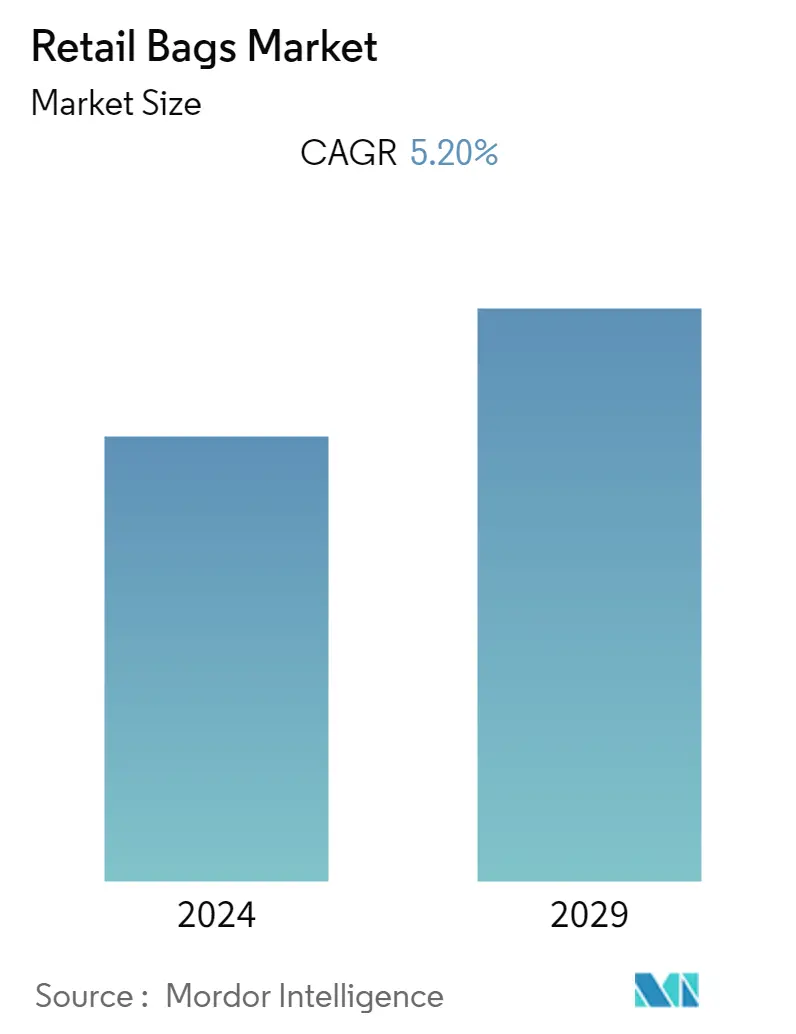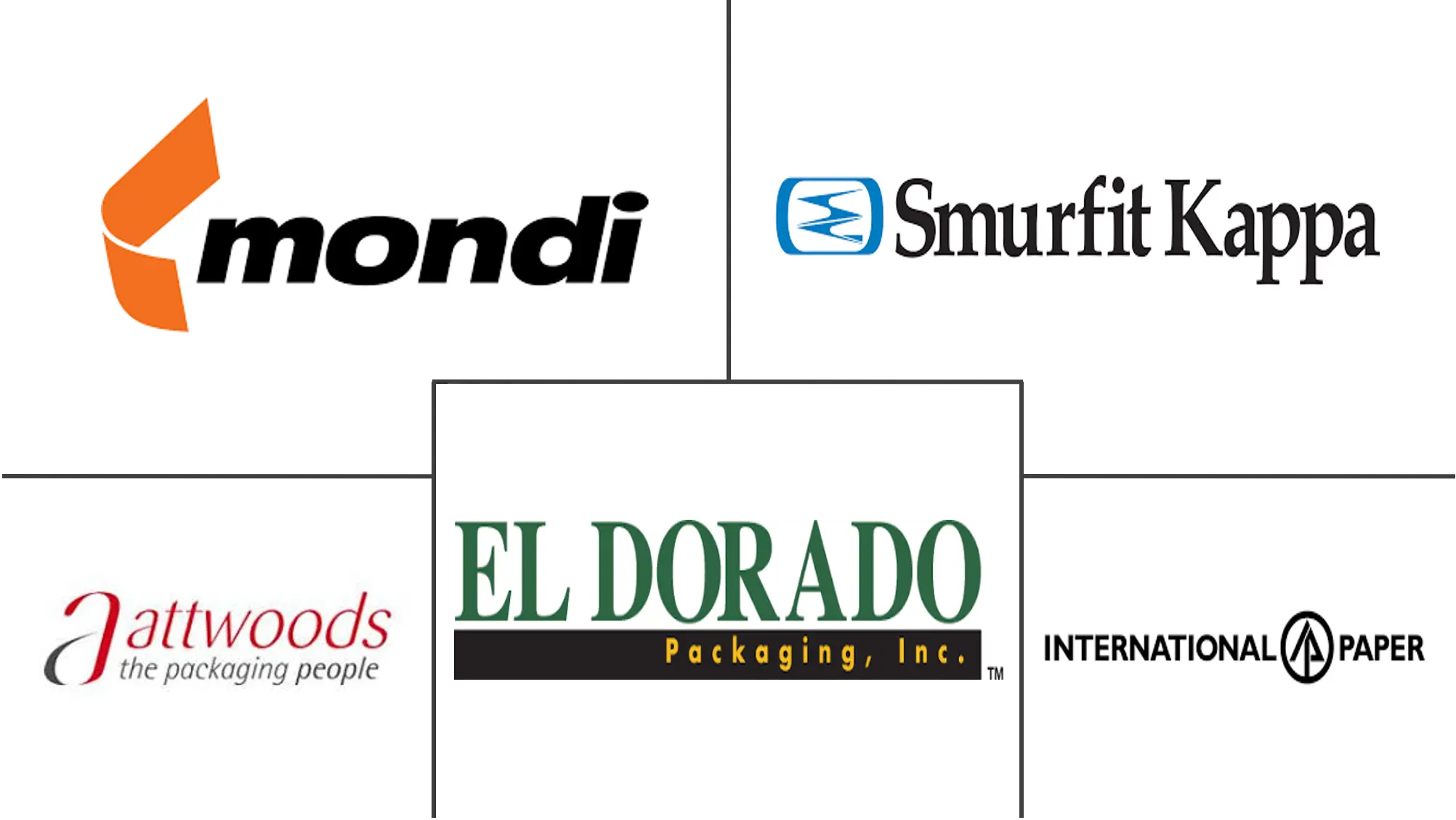Market Size of Retail Bags Industry

| Study Period | 2019 - 2029 |
| Base Year For Estimation | 2023 |
| CAGR | 5.20 % |
| Fastest Growing Market | Asia Pacific |
| Largest Market | Asia-Pacific |
| Market Concentration | Low |
Major Players
*Disclaimer: Major Players sorted in no particular order |
Retail Bags Market Analysis
The retail bags market is expected to record a CAGR of 5.2% over the forecast period (2022-2027). The rapidly increasing number of shopping malls, supermarkets, and developed retail sectors has been significantly feeding the global demand for retail bags. The retail bags market is increasing exponentially due to grown retail industries linked with the growing choice for eco-friendly packaging among customers.
- The growing regulations and bans for plastic material usage in retail bags have incrementally pushed paper material usage, and this is expected to proliferate the retail bag market during the forecast period. Also, increasing recycling and bio-based plastic usage is expected to play a pivotal role in the plastic material segment in the retail bag market that would replace the use of virgin plastic.
- Moreover, with the increasing demand for packaging across the end-user industries, the packaging waste generated is also rising. According to the United States Environmental Protection Agency (EPA,) packaging contributes to almost 77.9 metric tons of municipal solid waste per year. Almost 30% of the total amount of waste and packaging represents a staggering 65% of all household trash.
- On the other hand, the Japanese government launched a proposal in 2018 to reduce plastic waste by 25% until 2030. Also, a mandatory fee for plastic shopping bags was levied by July 2020. Similar laws have already been implemented in 66% of countries globally.
- Supermarkets in developed nations are regarded as heavy plastic use areas, with consumers opting for single-use retail bags. A curb on these segments with respect to plastic carry bag use has been witnessed, thus driving the market.
- However, the onset of coronavirus has set back the ban of single-use plastics. With early 2020 concerned about the risks of infection spread, the allied consumers of retail goods went back to throwaway packaging.
- Simultaneously, driven by consumer behavior, the bans on disposable items got delayed in the United Kingdom and the United States. For instance, California and Oregon lifted plastic bag bans, Maine delayed its own ban, and other multiple US cities and grocery chains banned reusable bags. These setbacks have caused an abrupt change after the long trend of governments banning or taxing the use of plastic bags. This has slightly given an edge for the development of paper-based retail bags.
Retail Bags Industry Segmentation
Retail carry bags are utilized in the retail industry to help consumers. The introduction of reusable bags into the retail carry bags industry has grown quickly. Retailers favor using plastic carry bags due to their properties, such as being easy for users, economical, and easy to store packaging format. The prevailing trend for the global retail carry bags market is biodegradable carry bags.
Furthermore, manufacturers of carrying bags are focused on giving environmentally friendly bags which produce smaller wastage. The retail bags market is segmented by material type (plastic, paper, other materials), end user (grocery store, food service, and other end users), and geography (North America, Europe, Asia-Pacific, Latin America, and Middle East & Africa).
| By Material Type | |||||
| |||||
| Paper | |||||
| Other Material Types (Jute, Cotton, Canvas) |
| By End-User | |
| Grocery Stores | |
| Food Service | |
| Other End-Users |
| By Geography | |
| North America | |
| Europe | |
| Asia Pacific | |
| Latin America | |
| Middle East and Africa |
Retail Bags Market Size Summary
The retail bags market is experiencing significant growth, driven by the expansion of shopping malls, supermarkets, and developed retail sectors globally. This growth is further fueled by the increasing consumer preference for eco-friendly packaging solutions, which has led to a shift from plastic to paper-based bags. The market is also influenced by regulatory measures and bans on plastic materials, encouraging the use of paper and recycled materials. The rise in recycling and bio-based plastics is expected to enhance the sustainability of plastic retail bags, reducing reliance on virgin materials. Despite the challenges posed by the COVID-19 pandemic, which temporarily reversed some trends towards single-use plastics, the long-term outlook for paper-based retail bags remains positive as consumers and retailers continue to prioritize environmentally friendly options.
The Asia Pacific region is anticipated to witness substantial growth in the retail bags market, supported by an increasing number of production facilities and a growing consumer base. The region's expanding retail sector and rising demand for paper pulp, particularly in China and India, are key factors contributing to this growth. The market is characterized by a high level of fragmentation, with numerous regional and global players engaging in strategic expansions, product innovations, and mergers and acquisitions to maintain competitiveness. Companies like Attwoods Packaging Company, Mondi Group PLC, and El Dorado Packaging, Inc. are prominent in the market, leveraging advanced distribution networks and continuous innovation to meet evolving consumer demands.
Retail Bags Market Size - Table of Contents
-
1. MARKET INSIGHTS
-
1.1 Market Overview
-
1.2 Market Drivers
-
1.2.1 Growing Preference for Paper Bags Globally
-
1.2.2 Rising Consumption of Personal Care Products and Cosmetics
-
-
1.3 Market Restraints
-
1.3.1 Restrictions on Using Plastic Retail Bags
-
-
1.4 Industry Attractiveness - Porter's Five Forces Analysis
-
1.4.1 Bargaining Power of Suppliers
-
1.4.2 Bargaining Power of Consumers
-
1.4.3 Threat of New Entrants
-
1.4.4 Threat of Substitute Products
-
1.4.5 Intensity of Competitive Rivalry
-
-
1.5 Assessment of the Impact of COVID-19 on the Market
-
1.6 Industry Value Chain Analysis
-
1.7 Types of Patterns in Retail Bags (Textured, Printed, Solid)
-
-
2. MARKET SEGMENTATION
-
2.1 By Material Type
-
2.1.1 Plastic
-
2.1.1.1 Polyethylene (PE)
-
2.1.1.2 Polypropylene (PP)
-
2.1.1.3 Other Plastic Types (PET, Polyester, rPET)
-
-
2.1.2 Paper
-
2.1.3 Other Material Types (Jute, Cotton, Canvas)
-
-
2.2 By End-User
-
2.2.1 Grocery Stores
-
2.2.2 Food Service
-
2.2.3 Other End-Users
-
-
2.3 By Geography
-
2.3.1 North America
-
2.3.2 Europe
-
2.3.3 Asia Pacific
-
2.3.4 Latin America
-
2.3.5 Middle East and Africa
-
-
Retail Bags Market Size FAQs
What is the current Retail Bags Market size?
The Retail Bags Market is projected to register a CAGR of 5.20% during the forecast period (2024-2029)
Who are the key players in Retail Bags Market?
Attwoods Packaging Company, Mondi Group PLC, Smurfit Kappa Group PLC, El Dorado Packaging, Inc. and International Paper Company are the major companies operating in the Retail Bags Market.

